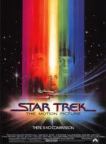 This will be the first of my Star Trek Movie reviews in the build-up to the release of the twelfth Star Trek movie, Star Trek Into Darkness.
This will be the first of my Star Trek Movie reviews in the build-up to the release of the twelfth Star Trek movie, Star Trek Into Darkness.
Star Trek: The Motion Picture was released on my birthday, September 28th 1979. Cruelly dubbed ‘The Motionless Picture’ by some critics, the film eschews Star Wars style spectacle and opts for a languid screenplay more akin to 2001: A Space Odyssey.
An unknown alien of unprecedented size and power is approaching Earth, destroying everything in its path. The only starship in range is the USS Enterprise, which must intercept and eliminate the threat to Earth. The story bears a strong resemblence both in plot and structure to the original series episode ‘The Changeling’.
Beyond the plot, the film bears little resemblance to the TV series which inspired it. The tone is somber almost, with Shatner delivering the most restrained performance of his career. There is almost no humour and scenes such as when Kirk is delivered to the Enterprise drag on ad naseum. This robs the film of any sense of momentum or urgency in responding to the threat to Earth.
The films major themes concern growing and evolving, indeed, the film superficially explores the next stage of human evolution. At the films conclusion, V’jur merges with Decker to become a transcendent being, fusing man with machine.
All future Star Trek’s would be character based, rather than focusing on really big Science Fiction ideas. Only Spock has a real character arc in the movie, as he realises that he cannot acheive Kolinhar – the purging of all emotion. Similarly, the probe realises that in order to evolve, it must meld with a human, because logic and knowledge are not enough to answer the question ‘why am I here’.
The film features incredible visual effects, which hold up even today, as well as a superb musical score, both of which were Oscar nominated. The sets and style established in this movie would continue to be employed until Star Trek Nemesis was released. Indeed, the film has a grandeur and scale that would not be matched until the 2009 Star Trek movie.
Having the greatly respected Robert Wise to direct the film speaks to its importance, yet the direction feels detached and workman like. Robert Wise also employed split-diopter lenses, where one side of the screen will be focused on the foreground while the other side of the screen will be focused on the background. This can result in a visible line demarking the two. This effect isn’t used much in modern movies, and the sudden drop-off in focus between the two sides of the screen can be very distracting.
To summarise then, this is an important and under rated film. It has serious flaws in that the pacing is too slow and there is not enough focus on the characters and relationships. That said, this is a proper, grown up and intelligent Science Fiction movie that does not pander to the lowest common denominator. I also love the films tagline of ‘the human adventure is just beginning’. Unusually for a Star Trek movie, I would recommend the novellisation of the film. It’s the only Star Trek novel written by Star Trek’s creator Gene Roddenberry and it conveys concepts and ideas more fully than the film.
Rating: 6/10


I love your commentary! Also, as a diehard Heinlein reader, I’m surprised by how the explorations of the themes of this movie hold up in the novelization, years after I read it. It was a story the people involved perhaps didn’t know how to really tell in immediately-post-Star-Wars 1970’s cinema. That may have changed…
Always nice to have feedback, thanks for reading 🙂